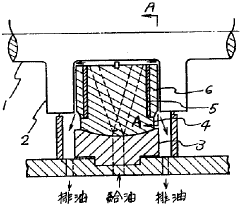Thrust Bearings With Adaptive Geometry And Surface Texturing For Improved Performance
Technology Background and Goals
This innovative approach combines adaptive geometry, which allows the bearing surface to deform and conform to the applied load, with surface texturing techniques that strategically introduce micro-features on the bearing surface. These micro-features can generate hydrodynamic effects, enhancing lubrication and load distribution. By integrating these two technologies, the thrust bearings can achieve superior performance, increased energy efficiency, and extended durability compared to conventional designs.
Market Demand Analysis
- Increasing Demand for High-Performance Bearings
The demand for thrust bearings with improved performance is driven by industries requiring high-speed, high-load, and low-friction operations, such as aerospace, automotive, and industrial machinery. - Energy Efficiency and Sustainability
Textured thrust bearings offer reduced friction and power losses, contributing to energy efficiency and sustainability goals across various sectors. - Emerging Applications
New applications, such as renewable energy systems (e.g., wind turbines) and medical devices, are driving the need for advanced thrust bearing solutions with adaptive geometry and surface texturing. - Market Growth Projections
The global market for textured thrust bearings is expected to experience significant growth, driven by technological advancements, stricter energy efficiency regulations, and the increasing adoption of these bearings across diverse industries.
Technology Status and Challenges
- Current Limitations Adaptive geometry thrust bearings face challenges in achieving precise and reliable shape control, as well as maintaining stable performance under varying operating conditions.
- Material Constraints The materials used in these bearings may have limitations in terms of deformation capabilities, fatigue resistance, and compatibility with lubricants.
- Manufacturing Complexities Producing adaptive geometry features and surface textures with high accuracy and consistency can be a complex and costly manufacturing process.
- Modeling and Simulation Challenges Accurately modeling the dynamic behavior of adaptive geometry bearings, including fluid-structure interactions and surface effects, remains a significant challenge.
- Integration and Control Issues Integrating adaptive geometry mechanisms with control systems and ensuring robust and responsive operation under varying loads and speeds can be complex.
Existing Technical Solutions
01 Structure and Materials
The bearing geometry, surface finish, and materials for components like thrust collar, runner, and pads affect load-carrying capacity, wear resistance, and durability.- Thrust Bearing Design and Materials: Various designs and materials are used to improve thrust bearing performance, including specific bearing materials, coatings, surface treatments for wear resistance, load capacity, friction reduction, and optimized geometries and configurations.
- Lubrication Systems and Methods: Effective lubrication is crucial, employing oil/grease lubrication, hydrostatic/hydrodynamic lubrication, and lubricant additives or coatings to improve lubrication and reduce friction.
- Thrust Bearing Assemblies and Arrangements: Performance is influenced by assembly and arrangement within the system, including integration with other components, alignment, and preloading.
- Monitoring and Control Systems: Monitoring and control systems optimize performance and prevent failures, involving sensors for monitoring parameters, control algorithms, and feedback mechanisms.
- Applications and Use Cases: Thrust bearings are used in various applications and industries with specific performance requirements, such as turbines, compressors, pumps, transportation, and aerospace.
02 Lubrication and Cooling Systems
Proper lubrication and cooling systems ensure lubrication, heat dissipation, reduced friction and wear, and extended service life, using various lubrication and cooling methods.Expand Specific Solutions03 Design and Analysis
Advanced techniques like FEA and CFD optimize design and predict performance under various conditions, improving load-carrying capacity, stiffness, and efficiency.Expand Specific Solutions04 Monitoring and Condition Assessment
Techniques like vibration analysis, temperature monitoring, and wear debris analysis evaluate performance and detect potential failures, enabling predictive maintenance and timely interventions.Expand Specific Solutions05 Materials and Coatings
Advanced materials and coatings, such as ceramics, solid lubricants, and composites, enhance performance and durability by improving wear resistance, reducing friction, and increasing load-carrying capacity.Expand Specific Solutions
Key Players Analysis
China Shipbuilding Industry Corp. No 703 Institute
Baker Hughes Holdings LLC
Key Technology Interpretation
- Designing the lubrication surface shape of a taper land thrust bearing to improve bearing performance.
- Utilizing taper land geometry to modify the lubrication film shape and pressure distribution.
- ^|Explore the integration of adaptive geometry and surface texturing to achieve optimal performance under varying operating conditions.
Regulatory and Environmental Impact on Adaptive Geometry Thrust Bearings
Stringent regulations govern the manufacturing processes, materials, and operational aspects of these bearings to ensure compliance with environmental standards. Particular emphasis is placed on minimizing the release of harmful substances and reducing energy consumption during production and operation. Adherence to these regulations is crucial for obtaining necessary certifications and approvals for commercial deployment.
Furthermore, the environmental impact assessment of adaptive geometry thrust bearings encompasses a comprehensive evaluation of their lifecycle. This includes analyzing the carbon footprint, resource utilization, and potential for recycling or reuse. Innovative design approaches that prioritize sustainability, such as the incorporation of eco-friendly materials and energy-efficient operational modes, are actively pursued to mitigate environmental concerns.
Economic Analysis of Adaptive Geometry Thrust Bearing Applications
The economic analysis of adaptive geometry thrust bearing applications hinges on several key factors. Firstly, the potential for improved performance and efficiency gains must be weighed against the additional manufacturing costs associated with the adaptive geometry and surface texturing features. A thorough cost-benefit analysis is essential to determine the economic viability across various industries and applications.
Furthermore, the market demand for such advanced bearing solutions plays a crucial role. Industries with stringent performance requirements, such as aerospace, automotive, and heavy machinery, may be more receptive to adopting these innovative technologies, provided the economic benefits outweigh the investment costs. Conversely, sectors with less demanding operating conditions may prioritize cost-effectiveness over performance optimization.
Additionally, the economic feasibility is influenced by the availability of skilled labor and specialized manufacturing capabilities required to produce adaptive geometry thrust bearings. Economies with a strong industrial base and access to advanced manufacturing technologies may have a competitive advantage in commercializing these solutions. Conversely, regions lacking the necessary infrastructure and expertise may face challenges in adopting and implementing these technologies cost-effectively.



